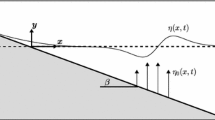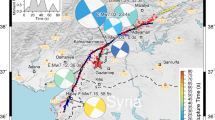Abstract
There are only a few analytical 2+1D models for tsunami propagation, most of which treat tsunami generation from a static deformation field isolated from the kinematics of the rupture. This work examines the behavior of tsunami propagation in a simple setup including a source time function which accounts for a time description of the rupture process on the tsunami source. An analytical solution is derived in the wavenumber domain, which is quickly inverted to space with the fast Fourier transform. The solution is obtained in closed form in the 1+1D case. The inclusion of temporal parameters of the source such as rise time and rupture velocity reveals a specific domain of very slow earthquakes that enhance tsunami amplitudes and produce non-negligible shifts in arrival times. The results confirm that amplification occurs when the rupture velocity matches the long-wave tsunami speed, and the static approximation corresponds to a limit case for (relatively) fast ruptures.










Similar content being viewed by others
References
Baddour, N., & Chouinard, U. (2017). Matlab code for the discrete Hankel transform. Journal of Open Research Software, 5(1), 4.
Bell, R., Holden, C., Power, W., Wang, X., & Downes, G. (2014). Hikurangi margin tsunami earthquake generated by slow seismic rupture over a subducted seamount. Earth and Planetary Science Letters, 397, 1–9.
Blaser, L., Krüger, F., Ohrnberger, M., & Scherbaum, F. (2010). Scaling relations of earthquake source parameter estimates with special focus on subduction environment. Bulletin of the Seismological Society of America, 100(6), 2914–2926.
Carrier, G. F., & Yeh, H. (2005). Tsunami propagation from a finite source. Computer Modeling in Engineering and Sciences, 10(2), 113–121.
Dutykh, D., & Dias, F. (2007). Water waves generated by a moving bottom. In A. Kundu (Ed.), Tsunami and Nonlinear Waves. Berlin: Springer.
Freund, L. B., & Barnett, D. M. (1976). A two-dimensional analysis of surface deformation due to dip-slip faulting. Bulletin of the Seismological Society of America, 66(3), 667–675.
Fuentes, M., Riquelme, S., Ruiz, J., & Campos, J. (2018). Implications on 1+ 1 D Tsunami runup modeling due to time features of the earthquake source. Pure and Applied Geophysics, 175(4), 1393–1404.
Hammack, J. L. (1973). A note on tsunamis: their generation and propagation in an ocean of uniform depth. Journal of Fluid Mechanics, 60(4), 769–799.
Hansen, P. C. (1994). Regularization tools: a Matlab package for analysis and solution of discrete ill-posed problems. Numerical Algorithms, 6(1), 1–35.
Kajiura, K. (1970). Tsunami source, energy and the directivity of wave radiation. Bulletin of Earthquake Research Institute, 48, 835–869.
Kânoǧlu, U., Titov, V. V., Moore, C., Stefanakis, T. S., Zhou, H., Spillane, M., et al. (2013). Focusing of long waves with finite crest over constant depth. Proceedings of the Royal Society A, 469(2153), 20130015.
Kervella, Y., Dutykh, D., & Dias, F. (2007). Comparison between three-dimensional linear and nonlinear tsunami generation models. Theoretical and Computational Fluid Dynamics, 21(4), 245–269.
Le Gal, M., Violeau, D., Ata, R., & Wang, X. (2018). Shallow water numerical models for the 1947 Gisborne and 2011 Tohoku-Oki tsunamis with kinematic seismic generation. Coastal Engineering, 139, 1–15.
Le Gal, M., Violeau, D., & Benoit, M. (2017). Influence of timescales on the generation of seismic tsunamis. European Journal of Mechanics-B/Fluids, 65, 257–273.
Ma, S. (2012). A self-consistent mechanism for slow dynamic deformation and tsunami generation for earthquakes in the shallow subduction zone. Geophysical Research Letters, 39, L11310.
Madariaga, R. (2003). Radiation from a finite reverse fault in a half space. Pure Applied Geophysics, 160, 555–577.
Nosov, M. A., & Kolesov, S. V. (2011). Optimal initial conditions for simulation of seismotectonic tsunamis. Pure and Applied Geophysics, 168(6–7), 1223–1237.
Novikova, L. E., & Ostrovsky, L. A. (1979). Excitation of tsunami waves by a traveling displacement of the ocean bottom. Marine Geodesy, 2(4), 365–380.
Novikova, L. E., & Ostrovsky, L. A. (1982). On the acoustic mechanism of tsunami wave excitation. Oceanology, 22(5), 693–697.
Okal, E. A., & Synolakis, C. E. (2003). A theoretical comparison of tsunamis from dislocations and landslides. Pure and Applied Geophysics, 160(10–11), 2177–2188.
Polet, J., & Kanamori, H. (2009). Tsunami earthquakes. In R. Meyers (Ed.), Encyclopedia of complexity and systems science. New York: Springer.
Ren, Z., Liu, H., Zhao, X., Wang, B., & An, C. (2019). Effect of kinematic fault rupture process on tsunami propagation. Ocean Engineering, 181, 43–58.
Saito, T. (2013). Dynamic tsunami generation due to sea-bottom deformation: analytical representation based on linear potential theory. Earth, Planets and Space, 65(12), 1411–1423.
Schmedes, J., Archuleta, R. J., & Lavallée, D. (2010). Correlation of earthquake source parameters inferred from dynamic rupture simulations. Journal of Geophysical Research, 115, B03304.
Tadepalli, S., & Synolakis, C. E. (1994). The run-up of N-waves on sloping beaches. Proceedings of the Royal Society of London Series A, 445(1923), 99–112.
Todorovska, M. I., & Trifunac, M. D. (2001). Generation of tsunamis by a slowly spreading uplift of the sea floor. Soil Dynamics and Earthquake Engineering, 21(2), 151–167.
Tuck, E. O., & Hwang, L. S. (1972). Long wave generation on a sloping beach. Journal of Fluid Mechanics, 51(3), 449–461.
Ward, S. N. (2001). Landslide tsunami. Journal of Geophysical Research, 106(B6), 11201–11215.
Williamson, A., Melgar, D., & Rim, D. (2019). The effect of earthquake kinematics on tsunami propagation. Journal of Geophysical Research: Solid Earth, 124, 11639–11650.
Yamashita, T., & Sato, R. (1974). Generation of tsunami by a fault model. Journal of Physics of the Earth, 22(4), 415–440.
Acknowledgements
This work was supported in part by the Programa de Riesgo Sísmico and FONDECYT grant 1170218.
Author information
Authors and Affiliations
Additional information
Publisher's Note
Springer Nature remains neutral with regard to jurisdictional claims in published maps and institutional affiliations.
Electronic supplementary material
Below is the link to the electronic supplementary material.
Supplementary material 1 (avi 19493 KB)
Appendices
Appendix 1: Detailed Mathematical Derivation
1.1 2+1D Case
In the following, detailed derivations are shown step by step. The classical solution for the irrotational long-wave tsunami approach in a constant ocean depth is
where \(\omega ^2 = gk\tanh (kh)\), \(k^2 = k_x^2 + k_y^2\), g is the gravity acceleration and h is the ocean depth. The seafloor displacement is modeled as
with
with the function \(S(x) = x{\mathcal {H}}(x(1-x)) + {\mathcal {H}}(x-1)\).
Firstly, we compute the Fourier–Laplace transform of T. Note that
Then, by the Laplace transform properties of time shift and scaling, we obtain
Now we need to compute the following Fourier transform:
which depends on the rupture model. In this case, a general bidirectional propagation is chosen.
The origin of the coordinate system is set at the starting rupture point. The rectangular fault is then divided into two parts, one segment to the north of length \(L_2\) and one segment to the south of length \(L_1\), accounting for the total length \(L = L_1 + L_2\). Thus, \(\zeta ^y_0(y) = {\mathcal {H}}\left( (L_2 - y)(y + L_1) \right)\) and \(t_V(y) = \frac{|y|}{V_r}\). Computation of expression (13) results in
where \(F(a,b,x) = \frac{e^{ax}}{a^2 + b^2}\big [\big (a\cos (bx) + b\sin (bx)\big ) + i\big ( a\sin (bx) - b\cos (bx) \big )\big ]\).
Inserting in Eq. 8,
Since \({\mathcal {L}}\left\{ \sin (at){\mathcal {H}}(t)\right\} (s) = \frac{a}{s^2 + a^2}\), we can define \(q(a,b,t) =: \frac{{\mathcal {H}}(t)}{a^2 - b^2 }\left( \frac{\sin (bt)}{b} - \frac{\sin (at)}{a}\right)\), and then we have that \({\overline{q}}(a,b,s) = \frac{1}{s^2 + a^2}\cdot \frac{1}{s^2 + b^2}\), with \(a = \omega\) and \(b = k_yV_r\).
Defining \(p(a,b,t,t_0) =: {\mathcal {L}}^{-1}\{se^{-st_0}{\overline{q}}(a,b,s)\}(t) = \partial _t q(a,b,t-t_0)\) and using the properties of the Laplace transform, Eq. 15 can be rewritten in terms of q and p (function arguments are omitted for the sake of simplicity)
where
and \(t_i = \frac{L_i}{V_r}, \, i \in \{1,2\}.\) Note that there are removable singularities in functions p and q when \(\omega = V_rk_y\).
The static deformation can be retrieved by letting \(V_r \rightarrow \infty\) and \(t_R \rightarrow 0\), which gives
Observe that the symmetric bilateral case has no frequency shifts and leads to a pure real spectrum
Finally, the water surface is inverted with a fast Fourier transform (FFT) algorithm:
1.2 1+1D Case
If 2D effects are neglected, \(\zeta _0^x(x) = H\) and \(\widehat{\zeta ^x_0}(k_x) = 2\pi \delta (k_x)\). Equation (16) then becomes
Again, the final solution \(\eta (y,t)\) can be retrieved from Eq. (20) with the 1D FFT.
In order to better understand analytically the behavior of the amplification as a function of rupture velocity, only a unidirectional rupture is treated with a instant rise time, that is to say, \(L_1 = 0, L_2 = L\) and \(t_R = 0\). Equation (20) becomes
with
and \(t^* = L/V_r\). To make possible the derivation of an analytical solution, it is necessary to neglect the dispersive effects: \(\omega (k_y) \approx ck_y\).
Performing the inverse Fourier transform term by term, by symmetry, each is of the form
Thus, the solution is
where \(t' = t - t^*\).
In particular, when \(\nu\) tends to 1 \((V_r = c)\), the maximum amplification at the end of the fault is
Appendix 2: Derivation of Function \(\psi ({x,y})\)
First, for any \(h>0\), let us define the function \(\varphi (x)\) as follows:
Then,
By the Leibniz rule,
The integral 28 can be easily evaluated by standard complex contour integration. For this type of integral, the contour is the rectangle defined by the corners (R, 0); \(\left( R,\frac{\pi i}{h}\right)\); \(\left( -R,\frac{\pi i}{h}\right)\); \((-R,0)\) enclosing a simple pole at \(\frac{\pi i}{2h}\), satisfying the convergence conditions.
Therefore, by the residue theorem,
Since \(\varphi (0) = 0\) and \(\int \text {sech}(ax)dx = \frac{1}{a}\arctan (\sinh (ax))+C\), integration of (28) allows us to retrieve \(\varphi\):
By using the property \(\arctan (a) \pm \arctan (b) = \arctan \left( \frac{a\pm b}{1 \mp ab}\right)\), it is equivalent to write
. Finally, replacing in( 27) and manipulating the arguments, the result holds.
Rights and permissions
About this article
Cite this article
Fuentes, M., Uribe, F., Riquelme, S. et al. Analytical Model for Tsunami Propagation Including Source Kinematics. Pure Appl. Geophys. 178, 5001–5015 (2021). https://doi.org/10.1007/s00024-020-02528-7
Received:
Revised:
Accepted:
Published:
Issue Date:
DOI: https://doi.org/10.1007/s00024-020-02528-7




